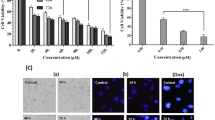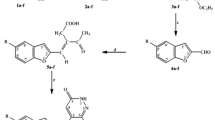Abstract
To examine the antitumor activity of a new derivative of ciprofloxacin called methoxyphenylcipro (CMPP). Cell viability was assessed using the MTT assay and apoptotic cells and reactive oxygen species were evaluated using flow cytometry. Results revealed that CMPP induces antiproliferative activity against breast cancer cells and melanoma and to a lesser extent against colorectal cancer cells. Interestingly, compared to ciprofloxacin, CMPP-induced a selective cytotoxicity against human cancer cells but not human normal fibroblasts. The potential of CMPP to inhibit cellular growth in MD-MB-486 breast cancer cells and MV3 melanoma cells was largely due to induction of caspase-dependent apoptosis, as confirmed by caspase-3 activation and cleavage of its substrate PARP. In addition, results indicated that CMPP-induced apoptosis is mediated by generation of reactive oxygen species. These findings revealed that CMPP has a selective antitumor activity against cancer cells and warrants further clinical evaluation.





Similar content being viewed by others
References
Anderson, V.A., and N. Osheroff. 2001. Type II topoisomerases as targets for quinolone antibacterials: turning Dr. Jekyll into Mr. Hyde. Current Pharmaceutical Design 7: 339–355.
Appelbaum, P.C., and P.A. Hunter. 2000. The fluoroquinolone antibacterials: Past, present and future perspectives. International Journal of Antimicrobial Agents 16: 5–15.
Aranha, O., R. Grignon, N. Fernandes, T.J. McDonnell, D.P. Wood Jr, and F.H. Sarkar. 2003. Suppression of human prostate cancer cell growth by ciprofloxacin is associated with cell cycle arrest and apoptosis. International Journal of Oncology 22: 787–794.
Aranha, O., D.P. Wood Jr, and F.H. Sarkar. 2000. Ciprofloxacin mediated cell growth inhibition, S/G2-M cell cycle arrest, and apoptosis in a human transitional cell carcinoma of the bladder cell line. Clinical Cancer Research 6: 891–900.
Ashkenazi, A., and V.M. Dixit. 1998. Death receptors: Signaling and modulation. Science 281: 1305–1308.
Bardia, A., J.O. Ebbert, R.A. Vierkant, P.J. Limburg, K. Anderson, A.H. Wang, J.E. Olson, C.M. Vachon, and J.R. Cerhan. 2007. Association of aspirin and nonaspirin nonsteroidal anti-inflammatory drugs with cancer incidence and mortality. Journal of the National Cancer Institute 99: 881–889.
Bredberg, A., M. Brant, and M. Jaszyk. 1991. Ciprofloxacin-induced inhibition of topoisomerase II in human lymphoblastoid cells. Antimicrobial Agents and Chemotherapy 35: 448–450.
Bromberg, K.D., A.B. Burgin, and N. Osheroff. 2003. Quinolone action against human topoisomerase II alpha: Stimulation of enzyme-mediated double-stranded DNA cleavage. Biochemistry 42: 3393–3398.
Chau, Y.P., S.G. Shiah, M.J. Don, and M.L. Kuo. 1998. Involvement of hydrogen peroxide in topoisomerase inhibitor beta-lapachone-induced apoptosis and differentiation in human leukemia cells. Free Radical Biology and Medicine 24: 660–670.
Cryns, V., and J. Yuan. 1998. Proteases to die for. Genes and Development 12(11): 1551–1570.
Debatin, K.M., D. Poncet, and G. Kroemer. 2002. Chemotherapy: Targeting the mitochondrial cell death pathway. Oncogene 21: 8786–8803.
Green, D.R., and J.C. Reed. 1998. Mitochondria and apoptosis. Science 281: 1309–1312.
Herbold, B.A., S.Y. Brendler-Schwaab, and H.J. Ahr. 2001. Ciprofloxacin: In vivo genotoxicity studies. Mutation Research 498: 193–205.
Herold, C., M. Ocker, M. Ganslmayer, H. Gerauer, E.G. Hahn, and D. Schuppan. 2002. Ciprofloxacin induces apoptosis and inhibits proliferation of human colorectal carcinoma cells. British Journal of Cancer 86: 443–448.
Higuchi, M., R.J. Proske, and E.T. Yeh. 1998. Inhibition of mitochondrial respiratory chain complex I by TNF results in cytochrome c release, membrane permeability transition, and apoptosis. Oncogene 17: 2515–2524.
Ikeda, K., K. Kajiwara, E. Tanabe, S. Tokumaru, E. Kishida, and Y. Masuzawa. 1999. Involvement of hydrogen peroxide and hydroxyl radical in chemically induced apoptosis of HL-60 cells. Biochemical Pharmacology 57: 1361–1365.
Inoue, M., N. Sakaguchi, K. Isuzugawa, H. Tani, and Y. Ogihara. 2000. Role of reactive oxygen species in gallic acid-induced apoptosis. Biological and Pharmaceutical Bulletin 23: 1153–1157.
Itoh, T., K. Mitsumori, S. Kawaguchi, and Y.F. Sasaki. 2006. Genotoxic potential of quinolone antimicrobials in the in vitro comet assay and micronucleus test. Mutation Research 603: 135–144.
Jacobs, E.J., M.J. Thun, E.B. Bain, C. Rodriguez, S.J. Henley, and E.E. Calle. 2007. A large cohort study of long-term daily use of adult-strength aspirin and cancer incidence. Journal of the National Cancer Institute 99: 608–615.
Lewanski, C.R., and W.J. Gullick. 2001. Radiotherapy and cellular signalling. Lancet Oncol 2: 366–370.
Mhaidat, N.M., Y.F. Wang, K.A. Kiejda, X.D. Zhang, and P. Hersey. 2007. Docetaxel-induced apoptosis in melanoma cells is dependent on activation of caspase-2. Molecular Cancer Therapeutics 6: 752–761.
Miclau, T., M.L. Edin, G.E. Lester, R.W. Lindsey, and L.E. Dahners. 1998. Effect of ciprofloxacin on the proliferation of osteoblast-like MG-63 human osteosarcoma cells in vitro. Journal of Orthopaedic Research 16: 509–512.
Mukherjee, A., S. Sen, and K. Agarwal. 1993. Ciprofloxacin: Mammalian DNA topoisomerase type II poison in vivo. Mutation Research 301: 87–92.
Scorrano, L., S.A. Oakes, J.T. Opferman, E.H. Cheng, M.D. Sorcinelli, and T. Pozzan. 2003. BAX and BAK regulation of endoplasmic reticulum Ca2+: A control point for apoptosis. Science 300: 135–139.
Shalit, I., N. Nasrallah, S. Bar-On, and M. Rabau. 1995. In vitro effect of ciprofloxacin and ofloxacin on murine and human colon carcinoma cell lines. Drugs 49: 296–297.
Shen, L.L., W.E. Kohlbrenner, D. Weigl, and J. Baranowski. 1989. Mechanism of quinolone inhibition of DNA gyrase: Appearance of unique norfloxacin binding sites in enzyme-DNA complexes. Journal of Biological Chemistry 264: 2973–2978.
Smart, D.J., H.D. Halicka, F. Traganos, Z. Darzynkiewicz, and G.M. Williams. 2008. Ciprofloxacin-induced G2 arrest and apoptosis in TK6 lymphoblastoid cells is not dependent on DNA double-strand break formation. Cancer Biology and Therapy 7: 113–119.
Somekh, E., D. Douer, N. Shaked, and E. Rubinstein. 1989. In vitro effects of ciprofloxacin and pefloxacin on growth of normal human hematopoietic progenitor cells and on leukemic cell lines. Journal of Pharmacology and Experimental Therapeutics 248: 415–418.
Thornberry, N.A., and Y. Lazebnik. 1998. Caspases: Enemies within. Science 281: 1312–1316.
Wesselborg, S., I.H. Engels, E. Rossmann, M. Los, and K. Schulze-Osthoff. 1999. Anticancer drugs induce caspase-8/FLICE activation and apoptosis in the absence of CD965 receptor/ligand interaction. Blood 93: 3053–3063.
Wu, J., X. Zhang, S. Gillespie, and P. Hersey. 2005. Selection for TRAIL resistance in melanoma cells with high proliferative potential. FEEBS Letters 579: 1940–1944.
Acknowledgments
We would like to acknowledge the Jordan University of Science & Technology, Irbid, Jordan, for the financial support.
Conflict of interest
The authors declare that they have no conflict of interest.
Author information
Authors and Affiliations
Corresponding author
Rights and permissions
About this article
Cite this article
Mhaidat, N.M., Qandil, A.M., Al-Balas, Q.A. et al. Methoxyphenylcipro induces antitumor activity in human cancer cells. Arch. Pharm. Res. 36, 1023–1028 (2013). https://doi.org/10.1007/s12272-013-0087-5
Received:
Revised:
Accepted:
Published:
Issue Date:
DOI: https://doi.org/10.1007/s12272-013-0087-5




